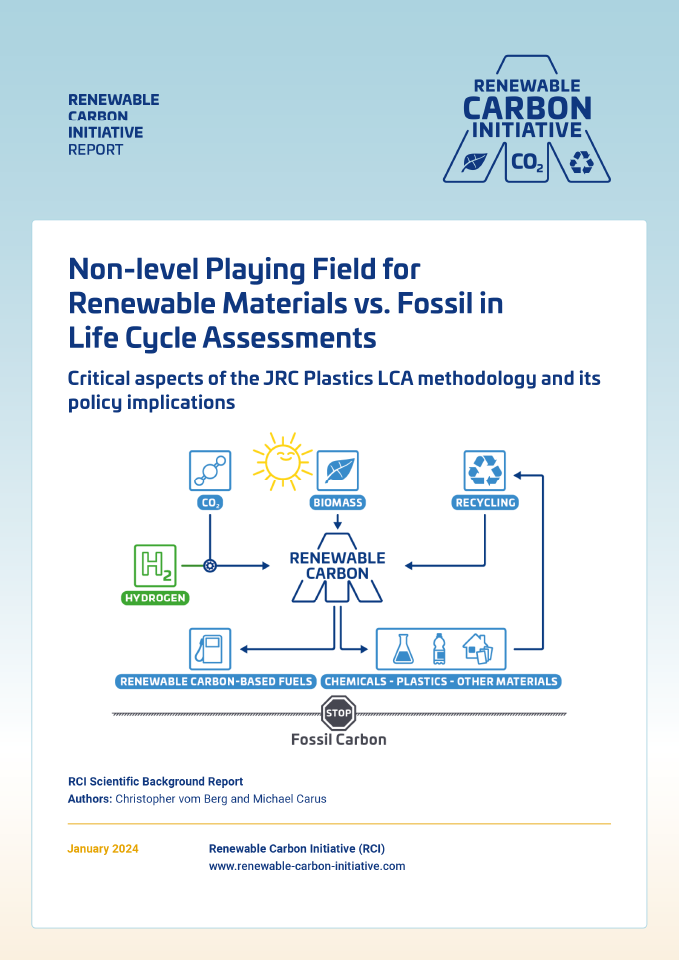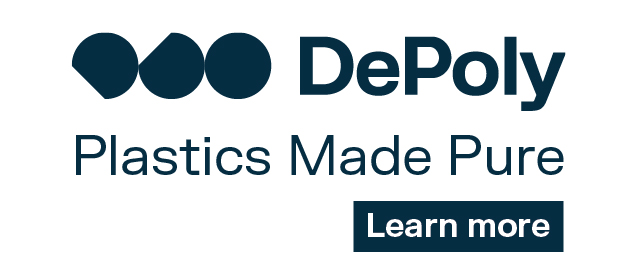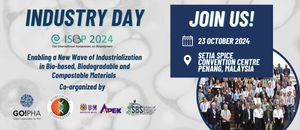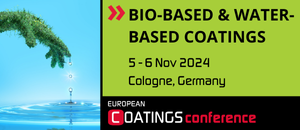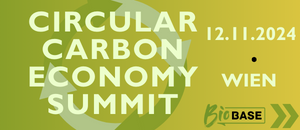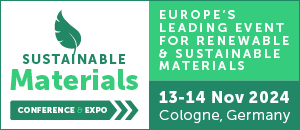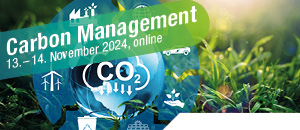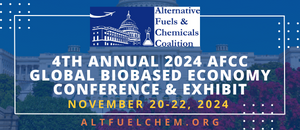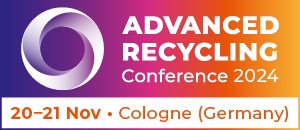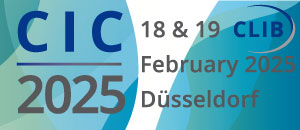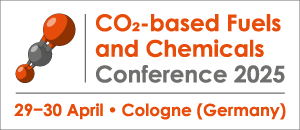In the race towards the European Commission’s net-zero targets, the shift from fossil-based to renewable materials is a critical journey for environmental sustainability. Available renewable carbon sources in this transition are biomass, carbon capture and utilisation (CCU) and recycling. Life Cycle Assessments (LCA) serve as the standard method for comparing the environmental impacts of different products or services. They provide the benchmark for comparing the environmental impacts of diverse products and services.
Amidst this imperative transition, a spotlight falls on the methodological intricacies presented by the Joint Research Centre (JRC), the scientific arm of the European Commission. For years, LCA experts have been discussing how to create a level playing field between fossil and non-fossil products, in particular addressing bio-based feedstock, and how to assess non-fossil products in LCA. The debate is still ongoing. The new scientific background paper summarises and discuss the main issues and problems, involving a recent methodological proposal by the Joint Research Center (JRC), the scientific body of the European Commission.
Unravelling the Issues: The JRC Plastics LCA Methodology
In 2021, the JRC published a study titled: “LCA of alternative feedstocks for plastic products”, commonly referred to as the JRC Plastics LCA Method. Alternative feedstocks refer to the same three feedstocks that RCI defines as renewable carbon: biomass, CO2 utilisation and recycling. The study describes a methodology developed by the JRC to assess the environmental performance of alternative feedstocks, potentially in comparison with fossil-based plastic products. While the methodology presents a detailed scientific approach, it has faced significant criticism from various stakeholders, mainly from the bio-based sector, even eliciting responses from the JRC. This RCI report aims to provide additional context, highlighting potential issues that might arise with implementation of the JRC Plastics LCA methodology. It serves as a pre-cursor to an upcoming RCI report on “Understanding LCA approaches and methodologies for different carbon sources”, aimed to be released later in 2024.
Key Challenges and Disparities
The JRC Plastics LCA method is a detailed scientific approach that aims to ensure that all environmental impacts are considered when assessing alternative feedstocks. However, from our perspective a central issue is that the methodology does not exist in a vacuum. Some methodological aspects remain unresolved and, more importantly, the policy landscape in which the methodology is implemented creates systemic disadvantages for innovative industries using alternative feedstocks. This creates additional barriers to the transition away from fossil feedstocks and towards these alternative feedstocks. Key issues at this interface are the following:
- The environmental footprint of fossil feedstock is likely to be underestimated, not transparent and lacks regional differentiation. Given that fossil feedstocks are the root and main cause of climate change, this is a critical issue that deserves more attention.
- Renewable/Alternative feedstocks are much more critically evaluated than fossil feedstocks. There is a discrepancy of scrutiny between the alternative,/renewable feedstocks and the current main feedstock – fossil crude oil.There is a long-standing inconsistency in methodological approach and regulatory support between energy (e.g., based on RED) and material use (e.g. based on JRC Plastics LCA) of alternative materials, which tends to favour energy use over material use. This is in stark contrast to the EU’s waste hierarchy, cascading use principles and circular economy objectives.
- Biogenic/Atmospheric carbon uptake cannot be transparently visualised in PEF and the JRC Plastics LCA method at the factory gate, to clearly illustrate the benefits of renewable carbon for sustainable carbon cycles.
- The methodology does not consider the interface of environmental sustainability assessment, policy design and the influence of the JRC on the European policy landscape. The JRC should facilitate future-oriented policy design, e.g., by including scenario analysis or sensitivity assessment.
Despite its scientific rigor, the methodology is still criticised as unbalanced in certain aspects. This includes debates on land use change, data reporting, indirect effects, biodiversity, carbon sequestration and the comparison of mature and immature systems
RCI Recommendations: Paving the Way Forward
There is an urgent need for a robust methodology to enable fair comparisons and to identify the most environmentally preferable solutions in order to facilitate the defossilisation of the chemical and derived material and plastics industries. The RCI has developed the following recommendations to meet these needs:
- Investigate the environmental impact of fossil feedstock at least at the same level of detail as the alternative feedstocks. Fossil carbon is the main cause of humanmade climate change, and it is a significant flaw that its environment footprint is likely underestimated, not transparent, scientifically disputed and lacking regional and technological differentiation.
- Require the same proof, sourcing demands and data provision of all feedstocks. The methodology should fairly demand the same data requirements, consider all land use impacts and all indirect impacts in the same way, and ask the same sustainability sourcing demands of all feedstocks. Scientifically uncertain criteria such as indirect land-use changes should not be integrated into the LCA methodology – as long as correspondingly uncertain aspects are also not included for crude oil production.
- Enable comparisons of novel and established products. Policy should be forward-driven, promoting innovation, guiding the economy and industry towards sustainable solutions. There needs to be options to assess the development of novel technologies to better compare their long-term environmental impacts compared to the established products. Sensitivity analysis of e.g., electricity generation and the agricultural system might provide insights into future environmental impacts of alternative feedstocks and derived products.
- Establish a level-playing field in LCA methodology between energy and material use. The current LCA methodology for bio-based fuels and bio-based energy is much more favourable than the LCA plastics methodology, systemically directing biomass utilisation towards energetic instead of material use. This is in complete opposite of EU’s waste hierarchy, circular economy targets, the cascading principle and policy aspects like the Communication on Sustainable Carbon Cycles and the Net-Zero Industry Act.
- Acknowledge the value of renewable carbon uptake in cradle-to-gate approaches. Many actors along the value chain are not able to accurately depict the emission-related advantages of renewable carbon-based products, in particular when they have to report carbon footprint information to their customers.
- Consider the policy interface & landscape of developed methodologies. While the JRC clearly states that the methodology is not a policy recommendation, it does to some extent reject reality with this statement. As the central science and knowledge service of the European Commission, its methodologies should always be considered also within the existing policy context. The JRC Plastics LCA methodology already influences how other measurement tools like the PEF are used in various policies.
- Develop future scenarios or add sensitivity analysis: the JRC is the scientific body of the European Commission, and should enable future-oriented policy-making by providing not only assessment of the status quo, but also an outlook of future developments. The development of future scenarios or sensitivity analysis of critical aspects like energy mix and agricultural system would facilitate such future-oriented policy-making.
- Develop concepts to reflect and incorporate positive environmental aspects. Soil carbon storage, land taken out of production for biodiversity and conservation aspects, and similar concepts are not reflected in LCA. But these are significant aspects for future sustainability, and LCA misses these aspects, despite it being the widely accepted methodology to assess environmental impacts today.
A Call to Action
As we navigate the complexities of transitioning to sustainable materials, a robust and fair LCA methodology is paramount. RCI urges stakeholders, policymakers, and industries to consider these recommendations for a more equitable and sustainable future.
The full report can be downloaded here: https://renewable-carbon.eu/publications/product/rci-non-level-playing-field-for-renewable-materials-vs-fossil-in-lcas
Would you like to learn more about the report? We cordially invite you to participate in our free webinar via Zoom on 29 February 2024: https://us06web.zoom.us/j/85377538023
Disclaimer
RCI members are a diverse group of companies addressing the challenges of the transition to renewable carbon with different approaches. The opinions expressed in these publications may not reflect the exact individual policies and views of all RCI members.
About RCI
The Renewable Carbon Initiative (RCI) is a global network of more than 60 prominent companies dedicated to supporting and accelerating the transition from fossil carbon to renewable carbon (bio-based, CO2-based and recycled) for all organic chemicals and materials. Its work focuses on scientific background reports, position papers, advocacy and networking.
Source
Renewable Carbon Initiative, press release, 2024-01-09.
Supplier
European Commission
Joint Research Centre (JRC)
Renewable Carbon Initiative (RCI)
Share
Renewable Carbon News – Daily Newsletter
Subscribe to our daily email newsletter – the world's leading newsletter on renewable materials and chemicals

